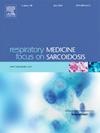哮喘和慢性阻塞性肺病患者IOS和AOS的振荡比比较。
IF 3.1
3区 医学
Q2 CARDIAC & CARDIOVASCULAR SYSTEMS
引用次数: 0
摘要
强迫振荡技术(FOT)使阻塞性肺疾病的小气道功能障碍(SAD)的评估无需费力。我们比较了哮喘和慢性阻塞性肺病患者的两种FOT模式-脉冲振荡法(IOS)和电波振荡法(AOS)的电阻和电抗比。我们回顾性分析了82例患者(58例哮喘,24例COPD)使用支气管扩张剂前后的配对IOS和AOS测量值。电阻(IOS为R5- r20 /R5; AOS为R5- r19 /R5)和电抗(X5/AX)比值采用相关分析和Bland-Altman分析进行比较。电阻比在器件之间显示出显著的一致性,平均差异极小。电抗比与IOS也有显著相关,但与IOS相关的电抗比高于AOS。这种差异在较高的X5/AX比率下增加,可能是由于设备特定的信号特性和校准差异。两种设备均观察到支气管扩张剂后的改善,使用IOS时X5/AX的变化更大(p本文章由计算机程序翻译,如有差异,请以英文原文为准。
Comparison of oscillometry ratios between IOS and AOS in patients with asthma and COPD
The forced oscillation technique (FOT) enables effort-independent assessment of small airway dysfunction (SAD) in obstructive lung diseases. We compared resistance and reactance ratios between two FOT modalities—impulse oscillometry (IOS) and airwave oscillometry (AOS), in patients with asthma and COPD. We retrospectively analysed paired pre- and post-bronchodilator IOS and AOS measurements from 82 patients (58 asthma, 24 COPD). Resistance (R5–R20/R5 for IOS; R5–R19/R5 for AOS) and reactance (X5/AX) ratios were compared using correlation and Bland-Altman analyses. Resistance ratios showed significant agreement between devices, with minimal mean differences. Reactance ratios were also significantly correlated but were higher with IOS than AOS. This difference increased at higher X5/AX ratios, likely due to device specific signal characteristics and calibration differences. Post-bronchodilator improvements were observed with both devices, with a greater change in X5/AX using IOS (p < 0.05). In conclusion resistance ratios were comparable between IOS and AOS, supporting their clinical use across devices. In contrast, reactance ratios differed, highlighting the need for device-specific normative values and improved standardization. FOT-derived ratios may offer a practical alternative to absolute values for assessing SAD in asthma and COPD.
求助全文
通过发布文献求助,成功后即可免费获取论文全文。
去求助
来源期刊

Respiratory medicine
医学-呼吸系统
CiteScore
7.50
自引率
0.00%
发文量
199
审稿时长
38 days
期刊介绍:
Respiratory Medicine is an internationally-renowned journal devoted to the rapid publication of clinically-relevant respiratory medicine research. It combines cutting-edge original research with state-of-the-art reviews dealing with all aspects of respiratory diseases and therapeutic interventions. Topics include adult and paediatric medicine, epidemiology, immunology and cell biology, physiology, occupational disorders, and the role of allergens and pollutants.
Respiratory Medicine is increasingly the journal of choice for publication of phased trial work, commenting on effectiveness, dosage and methods of action.
 求助内容:
求助内容: 应助结果提醒方式:
应助结果提醒方式:


